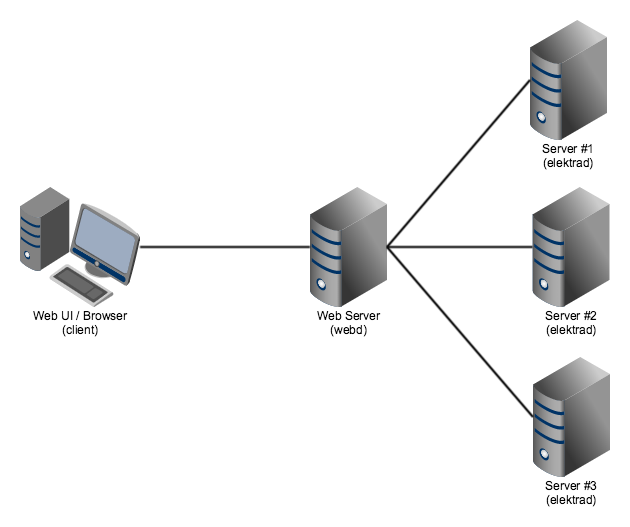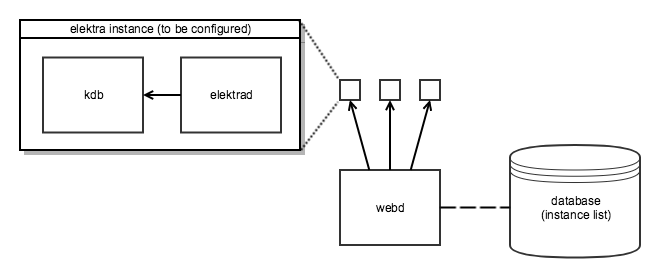an API and web user interface to remotely manage Elektra instances
The configuration view of elektra-web is similar to the tree view of the qt-gui, but with dynamic fields rendered via key metadata.
Elektra-web requires:
- Elektra with the
yajlplugin installed - A recent node.js installation (at least 6.x)
- Go with version > 1.13
To build Elektra with the elektra-web tool:
- Install Node.js, Go and dependencies for
yajlplugin (see links above) - Configure libelektra build with the elektra-web tool, e.g.
cmake .. -DTOOLS="kdb;web" - Build libelektra:
make - Install libelektra:
sudo make install
- Start an elektrad instance:
kdb run-elektrad - Start the client:
kdb run-web - You can now access the client on: http://localhost:33334
- Create and run a new docker container:
docker run -d -it -p 33333:33333 -p 33334:33334 elektra/web - You can now access the client on: http://localhost:33334
- Install dependencies (see above)
- Clone libelektra repo and
cd libelektra/src/tools/web - Install and start an elektrad instance:
cd elektradgo build./elektrad(replaceskdb run-elektrad)
- Install and start the client (connects to the elektrad instance):
cd clientnpm installnpm start(replaceskdb run-web)
- You can now access the client on: http://localhost:33334
If you do not want to configure multiple instances, you can set the INSTANCE environment variable to the server you want to configure. You can also set user:/sw/elektra/web/#0/current/instance to the host. Make sure to enter a full HTTP URL, e.g. http://localhost:33333.
If this configuration option is set, elektra-web will load the configuration page for that instance instead of the main overview page.
If you want to host elektra-web with the client and elektrad on the same instance, after starting elektrad via kdb run-elektrad, you can run start the client as follows:
It is also possible to set visibility by prefixing the host with VISIBILITY@.
For example (advanced visibility, user is default):
Now, when you open http://localhost:33334 in your browser, the configuration page for the instance will be opened immediately.
It is possible to change the kdb executable that elektra-web uses by setting the KDB environment variable, this is not needed for elektrad.
For example:
Elektra web consists of multiple components:
- (multiple) servers running an elektra daemon (`elektrad`)
- a single server to communicate with the elektra daemons and serve the client (`webd`)
- a web browser that accesses the client (Web UI) on the `webd` server (`client`)


API blueprints are available for both APIs:
- elektrad, documentation: https://elektrad.docs.apiary.io/
- webd, documentation: https://elektrawebd.docs.apiary.io/
In order to test API on localhost, you have to start elektrad instance. You can do it in two ways:
- run manually (if you would like to start it manually or you don't have eletrad-web tool installed)
cd libelektra/src/tools/webcd elektradgo build./elektrad
- by installing elektrad tool together with Elektra and run it
- please see the section
Building with elektra-web Tool
- please see the section
Now the server is runing on http://localhost:33333. After that you can test API with help of Postman or other tool, which allows to send REST API requests.
Additional note. It is recommended to install the elektrad tool than starting the server manually. When Elektra is installed, the kdb command together with its tools is installed globally. For instance, whenever you would like to write any shell script, which has to start a REST API server, you can just add the following line kdb run-elektrad inside your file and save it. After that, the created shell script can be executed from any directory.
Examples:
let's create the new key-value pair user:/test and set its value to 5. You can do it next way:
- through the command terminal kdb set user:/test 5
- through the rest api using curl curl -X PUT -H "Content-Type: text/plain" --data "5" http://localhost:33333/kdb/user/test
The output of the commandline tool will be: Set string to "5". If the specified key didn't exist before, then the output will be Create a new key user:/test with string "5". Elektrad will respond with code 200.
Now, the command
will return us the value of the specified key user:/test, which is stored in the database right now
Currently, webd does not support authentication. The best way to work around this is to use a reverse proxy (e.g. nginx reverse proxy).
Once you set up a reverse proxy on your web server, you can use it to authenticate users, e.g. by username/password auth
elektrad/ - contains the daemon to interact with a single elektra instance webd/ - contains a daemon to serve the client and interact with multiple elektra instances
client/ - contains the elektra-web client (Web UI)
src/actions/- Redux actions to access the KDB or display notifications in the UIsrc/components/- React componentspages/- pages in the appHome.jsx- the main page (overview of all instances)Configuration.jsx- configuration page (single instance)
TreeItem/- contains all UI components related to a single item in the tree viewdialogs/- these dialogs are opened when certain actions are pressed (icons next to the tree items)AddDialog.jsx- dialog to create a new (sub-)keyDuplicateDialog.jsx- dialog to duplicate a keyEditDialog.jsx- dialog to edit a key valueRemoveDialog.jsx- dialog to confirm the removal of a keySettingsDialog.jsx- dialog to edit metadata (new metadata can be implemented here)*SubDialog.jsx- sub-dialogs of the SettingsDialog
fields/- special input fields to display various values
App.jsx- defines app structure and routes
src/index.js- main entry point of the app (fetches instances and renders UI)src/containers/- contains components that are connected to Reduxsrc/css/- contains CSS stylessrc/reducers/- contains Redux reducers (used to process actions)
Lockfiles (package-lock.json) can be updated by simply deleting the current lock file and running npm install, which creates a new lock file.
Check for outdated dependencies via npm outdated. Dependencies can then be updated by running npm update.
Run the following command in the scripts/docker/web/ directory, replacing 1.5.0 with the latest version:
Test the image:
Publish it to the docker registry:
- Create a new sub dialog by, for example, copying the
NumberSubDialog.jsxfile (or similar) to a new file in theclient/src/components/TreeItem/dialogsfolder. - Include the sub dialog by adding it to the
SettingsDialog.jsxfile in the same folder. For example, it could be added before the AdditionalMetakeysSubDialog at the end of the file:
- Mark the meta keys as handled by adding them to the
HANDLED_METADATAarray inclient/src/components/TreeItem/dialogs/utils.js:
- Validation can then be added by handling metadata in the
client/src/components/TreeItem/fields/validateType.jsfile to thevalidateTypefunction. - Rendering fields in a special way when certain metakeys are present can be done by adjusting the
renderSpecialValuefunction in theclient/src/components/TreeItem/index.jsfile.
 1.8.13
1.8.13